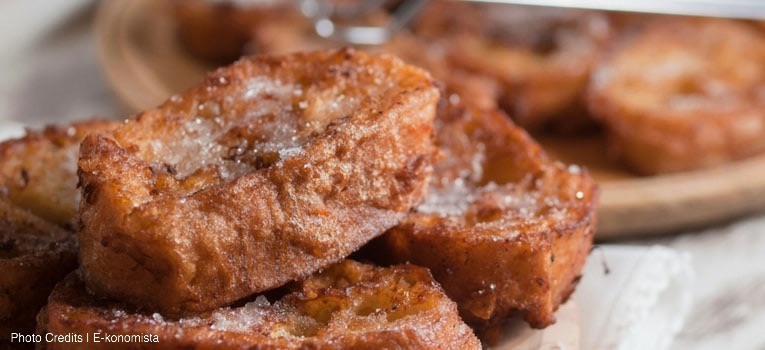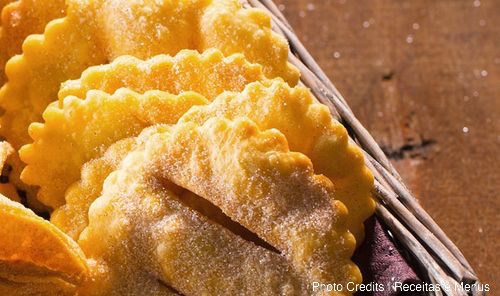|
Two subjects we don’t play with... Christmas in Portugal means quality time spent with the family: long meals, full tables and happy loud people. Everyone is well aware we take food seriously, and the sweets we make for Christmas have been part of our traditions for generations. Every family claims to have the best recipe, and it is true. Every single one of them is to die for! Here are a few (believe me, there are more!) of our favourites: Bolo Rei and Bolo RainhaThe King and the Queen of the cakes. Literally! Legend has it that this cake came in honor of the three Wise Men, who took the offerings to baby Jesus. The golden crust symbolises the gold, the dried and crystallised fruits represent the mirth, and the beautiful aroma the incense. As far as we know, the first time bolo rei was sold in Portugal was around 1870. It all started with the king, but in recent years the queen has been conquering many homes. The main difference is that in the original recipe the cake is decorated with dried and crystallised fruits, and the queen only has dried fruits (she doesn’t need to show off the glitter) . It is mandatory to place either one of them at the table of any Portuguese family, which should be fairly easy as they can be found in any bakery during Christmas season. RabanadasAlso know as golden slices (fatias douradas), these are pretty similar to the famous french toasts, but instead of using milk we make a grown-up syrup! The recipe is quite simple: grab the slices of bread, soak them in sugary syrup, coat them with egg wash and then fry them until golden! On the side, we also make a syrup with wine, honey and cinnamon to drown the rabanadas before scoffing them. We read somewhere that in the 15th century rabanadas were even recommended to women who recently had given birth to help them recover. Nowadays we wouldn’t go that far, even though no one is able to avoid the sugar rush. SonhosSonhos translates to dreams, and so they should. They are little fried pastries that are specially made for Christmas. Even though they are typical in the northern regions of Portugal, their origin is German, where they have been created by a Turkish baker who wanted to make a pastry that represented the sun. The batter is quite easy to make. Start by boiling milk with butter, a dash of salt and some lemon peel. Add the flour and stir with a wooden spoon till the mix doesn’t stick to the side of the bowl. Let it cool down for a while and then add the eggs carefully. Stir vigorously until the batter is smooth. After having the mix ready, drop a spoon of the batter in hot oil and wait for your dreams to come true. Before serving sprinkle them with cinnamon or caster sugar for a snow like effect. You can also make a sugary syrup on the side and then pour it on top! AletriaIt is believed aletria was brought by the arabs to the Iberic Peninsula on the 8th or 9th century. The word does originate from the arabic word alatríyya. It is made with what we now commonly know as vermicelli noodles, but in Portugal we use them for sweets. Depending on the location aletria is made, it looks and tastes a bit different. In the Beiras the consistency is harder and you can even cut it by the slice, but in the Minho region it is creamier. Goes without saying that no matter the recipe, the taste is unanimous: delicious! According to the traditional recipe you should start by boiling milk with a bit of lemon or orange peel, brown sugar and butter. Add the aletria (after boiling it in salted water) and, when it reduces, take it off the heat and add the whisked egg yolks one at a time. After stirring bring the mix back to the heat for a few minutes without allowing it to boil. Pour it in a tray, get rid of the citric peel and sprinkle some cinnamon powder on top! Filhós/FilhosesThe tradition started when people decided to offer filhoses and Port wine to the boys who went singing door to door after midnight mass. These pastries are definitely in the Christmas memories of thousands of portugueses families. Sitting around the kitchen table or by the fireplace, preparing the dough and waiting for it to prove all morning. It is almost impossible to pick the best filhós recipe, as there is one for almost every region. Even the names change! However, they all share the same core ingredients which are flour, eggs, milk, yeast and olive oil. After the batter proves, traditionally it is then fried in olive oil. You can find them in various shapes, with different ingredients and flavours. It doesn’t hurt if you drop a bit of sugar, honey or orange zest on top, just for fun! Azevias“The secret lies in the dough!”, grandmas from north to south tell their little helpers. And that’s where it all starts, by making the mix for the dough and kneading it. Then you can set it aside to rest while you get on with the filling. The base of the filling is made with chickpea or sweet potato, and then egg yolks and grated almond. The mix should be a silky puree. To it add sugary syrup, cinnamon and citrus zest. Now back to the dough! Roll it until you have a thin layer, cut it in circular shapes and add the filling. Just like you were making “half-raviolis”! Can you guess what happens next? They are fried and covered in sugar and cinnamon, of course! Tronco de NatalNo Christmas is over without a chocolate dessert… For this one we have to thank the French. During the 19th century, Europe’s population grew widely due to the discoveries in the medical field and the spread of various ways of artistic expression and creativity. This development hit Portugal too, and we imported the chocolate log (in Portuguese tronco de Natal). It is made from a basic cake mix of flour, butter, sugar, eggs and baking powder. When adding the dry ingredients, don’t forget to add cacao powder too. Put it in the oven for around 15 minutes and let it cool down afterwards. For the glaze add double cream, butter and dark chocolate and stir it until smooth and glossy. Pour the chocolate ganache on top of the cake and draw thin lines on the surface with a fork, to give it a trunk texture. Then you can decorate it with chocolate shards, currants, blueberries and other wild berries. If you followed the brief, in the end it should resemble a wooden log! Even though these are the most typical ones, from north to south they might vary a bit… and because Portuguese are well known for their sweet tooth, you may also find a few more that are secret family recipes. You never know… it’s Christmas after all!
0 Comments
Leave a Reply. |
Categories
All
|
Telephone+351 938 503 009
|
|
Turismo de Portugal RNAVT nº 6915
|










